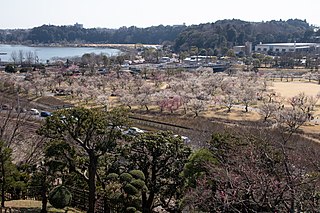
Ibaraki Prefecture is a prefecture of Japan located in the Kantō region of Honshu. Ibaraki Prefecture has a population of 2,828,086 and has a geographic area of 6,097.19 square kilometres. Ibaraki Prefecture borders Fukushima Prefecture to the north, Tochigi Prefecture to the northwest, Saitama Prefecture to the southwest, Chiba Prefecture to the south, and the Pacific Ocean to the east.

Matsumoto Castle, originally known as Fukashi Castle, is one of Japan's premier historic castles, along with Himeji and Kumamoto. It was the seat of Matsumoto Domain under the Edo Period Tokugawa shogunate. It is located in the city of Matsumoto, in Nagano Prefecture.

Matsue Castle is a Japanese castle located in Matsue, Shimane Prefecture.
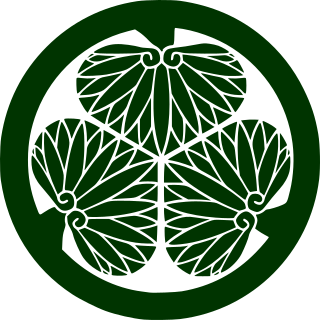
The Tokugawa clan is a Japanese dynasty which produced the Tokugawa shoguns who ruled Japan from 1603 to 1868 during the Edo period. It was formerly a powerful daimyō family. They nominally descended from Emperor Seiwa (850–880) and were a branch of the Minamoto clan through the Matsudaira clan. The early history of the clan remains a mystery. Nominally, the Matsudaira clan is said to be descended from the Nitta clan, a branch of the Minamoto clan, but the likelihood of this claim is considered quite low or untrue.

The Matsudaira clan was a Japanese samurai clan that descended from the Minamoto clan. It originated in and took its name from Matsudaira village, in Mikawa Province. During the Sengoku period, the chieftain of the main line of the Matsudaira clan, Matsudaira Motoyasu became a powerful regional daimyo under Oda Nobunaga and Toyotomi Hideyoshi and changed his name to Tokugawa Ieyasu. He subsequently seized power as the first shōgun of the Tokugawa shogunate which ruled Japan during the Edo period until the Meiji Restoration of 1868. Under the Tokugawa shogunate, many cadet branches of the clan retained the Matsudaira surname, and numerous new branches were formed in the decades after Ieyasu. Some of those branches were also of daimyō status.

Mito was a Japanese domain of the Edo period. It was associated with Hitachi Province in modern-day Ibaraki Prefecture.

Sasayama Castle is an early Edo Period Japanese castle located in the city of Tamba-Sasayama, Hyōgo, Japan. It ruins have been protected as a National Historic Site since 1956.

Aoba Castle is a Japanese castle located in Sendai, Miyagi Prefecture, Japan. Throughout the Edo period, Aoba Castle was home to the Date clan, daimyō of Sendai Domain. The castle was also known as Sendai-jō (仙台城) or as Gojō-rō (五城楼). In 2003, the castle ruins were designated a National Historic Site.
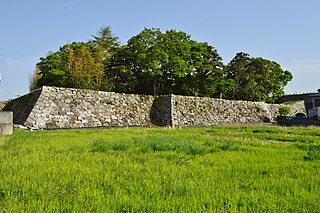
Obama Castle was a seaside-style castle located in what is now the city of Obama, Fukui Prefecture, Japan. During the Edo period, it was the headquarters of a junior branch of the Sakai clan, who were hereditary daimyō of Obama Domain under the Tokugawa shogunate. The castle was also known by the name of Unpin Castle.

Nihonmatsu Castle is a Japanese castle located in what is now the city of Nihonmatsu, northern Fukushima Prefecture, Japan. Throughout most of the Edo period, Nihonmatsu Castle was home to the Niwa clan, daimyō of Nihonmatsu Domain. The castle was also known as "Kasumi-ga-jō" (霞ヶ城) or "Shirahata-jō" (白旗城). The castle is one of the 100 Fine Castles of Japan, and in 2007 was designated a National Historic Site. The castle grounds are also a noted venue for viewing sakura in spring.

Tsu Castle was a Japanese castle located in the city of Tsu, Mie Prefecture, Japan. During the Edo period, Tsu Castle was home to the Sudo clan, daimyō of Tsu Domain, who dominated the provinces of Ise and Iga under the Tokugawa shogunate. The castle was also known as "Anotsu-jō" (安濃津城) after the ancient name for Tsu. The castle ruins are a Prefectural Historic Site.
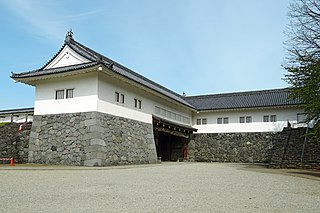
Yamagata Castle is a flatland-style Japanese castle located in the center of the city of Yamagata, eastern Yamagata Prefecture, Japan. Throughout the Edo period, Yamagata Castle was the headquarters for the daimyō of Yamagata Domain. The castle was also known as "Ka-jō" (霞城). The castle grounds are protected as a National Historic Site by the Japanese government

Kasama Castle is a Japanese castle located in Kasama, central Ibaraki Prefecture, Japan. At the end of the Edo period, Kasama Castle was home to a junior branch of Makino clan, daimyō of Kasama Domain, but castle and domain went through many changes in clans during the early Edo period.

Tsuchiura Castle is a flatland-style Japanese castle located in Tsuchiura, southern Ibaraki Prefecture, Japan. At the end of the Edo period, Tsuchiura Castle was home to the Tsuchiya clan, daimyō of Tsuchiura Domain. The castle was also known as "Ki-jō".

Sakura Castle was a 17th-century castle, now in ruins, in Sakura, Chiba Prefecture. It was designated one of Japan's Top 100 Castles by the Japanese Castle Foundation.

Tsuwano Castle was a Japanese castle located in what is now the city of Tsuwano, Shimane Prefecture, in the San'in region of far western Japan. Its ruins have been protected by the central government as a National Historic Site since 1942. In its early history, it was called Sanbonmatsu Castle or Ipponmatsu Castle. During the Edo Period, it was the center of Tsuwano Domain ruled by the Kamei clan; however, the administrative offices and daimyō residence were located at the base of the mountain to avoid the steep mountain paths.

Tsutsujigasaki Castle was the fortified residence of the final three generations of the Takeda clan, located in the center of the city of Kōfu, Yamanashi Prefecture, Japan. It is not a Japanese castle in the proper sense of the word, and is not referred to as a "castle" in Japanese, as it was famously the policy of the Takeda clan to "make men your castle, men your walls, men your moats". Nevertheless, it is listed as one of Japan's Top 100 Castles. The ruins have been protected as a National Historic Site since 1938. The site is open to the public and now contains the Takeda Shrine, a Shinto shrine dedicated to the deified spirits of the Takeda clan.
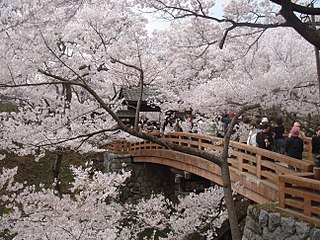
Takatō Castle is a Japanese castle located in the city of Ina, southern Nagano Prefecture, Japan. At the end of the Edo period, Takatō Castle was home to a cadet branch of the Naitō clan, daimyō of Takatō Domain. The castle was also known as Kabuto Castle. Built sometime in the 16th century, it is now largely ruins.

Takaoka Castle was a flatland-style Japanese castle in what is now the city of Takaoka, Toyama Japan. It was originally constructed in 1609, and was only used for a few years before being dismantled. The site of its ruins are now a park. The castle is designated one of Japan's Top 100 Castles by the Japanese Castle Foundation. The ruins are protected as a National Historic Site.
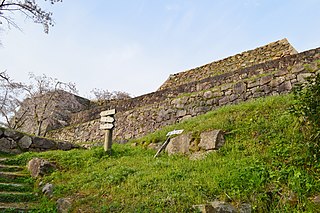
Yonago Castle was an Edo period Japanese castle located in the city of Yonago, Tottori Prefecture, in the San'in region of Japan. Its ruins have been protected as a National Historic Site since 2006. It was also called Kume Castle (久米城) or Minatoyama Castle (湊山城),























